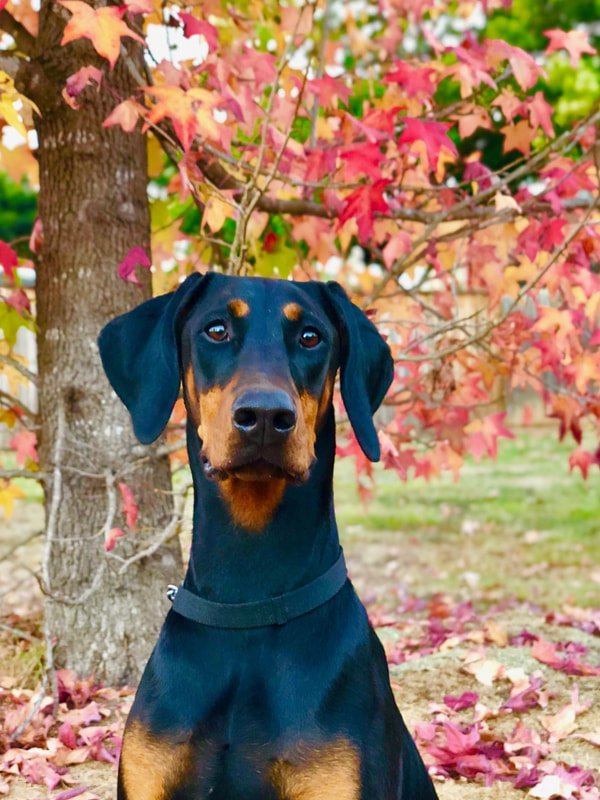The Dobermann
With its streamlined, elegant appearance and balanced structure, the Dobermann is a breed that epitomises modernity and functionality. Its short, glossy coat, striking physique, and well-defined musculature give it a sharp, contemporary aesthetic. The Dobermann is not just a product of 20th-century breeding; it is a breed designed with purpose and precision.
While the Dobermann's appearance is clean and simple, its temperament and origins are far more complex. This breed blends the fiery, quick reactions of terriers with the intelligence, strength, and reliability of guard and herding breeds. Initially developed in the late 19th century, the Dobermann was crafted for roles in law enforcement, military operations, and as a protector-companion within the home.
The Dobermann takes its name from Louis Dobermann, a tax collector and nightwatchman from Apolda, Germany, who sought to create a dog that was both protective and versatile. He is believed to have combined several breeds to achieve these traits, although records of the exact combinations are lacking. After his death in 1894, the breed was named in his honor. Germans initially called it the "Dobermann-Pinscher," but the "Pinscher" was later dropped because the term (German for "terrier") no longer described the breed’s characteristics. The British followed suit, renaming the breed simply "Dobermann."
Interestingly, the Dobermann is unrelated to the Miniature Pinscher, despite their similar names. The Miniature Pinscher is an entirely separate breed with a different lineage.
Although no definitive records exist of the Dobermann's ancestry, it is widely accepted that Louis Dobermann combined traits from a variety of breeds to meet his objectives. Crosses with the Black and Tan Manchester Terrier and the black English Greyhound were likely used to enhance the breed's appearance and agility. The Old German Shepherd, now extinct, played a crucial role, contributing intelligence, ruggedness, and soundness in both mind and body. The German Pinscher added a fiery temperament and quick reflexes, hallmarks of terriers.
Other breeds believed to have influenced the Dobermann include the Rottweiler, known for its strength, bravery, and guarding instincts, and the Weimaraner, which provided hunting, scenting, and retrieving abilities. The Beauceron, a French herding dog, is also sometimes mentioned as a possible ancestor, lending additional versatility and endurance.
The Dobermann quickly gained popularity outside of Germany due to its courage, loyalty, and versatility. In the United States, the breed's growth was driven by selective breeding programs that refined its structure and temperament, ensuring it remained a dependable working and companion dog. The Dobermann was officially recognised by the American Kennel Club (AKC) in 1908.
Dobermanns are known for their sleek, muscular bodies and distinct rust-red markings that stand out against coat colors, which include black and reddish-brown. Males typically range from 65 to 69 cm at the shoulder and weigh between 40 and 45 kg, while females are slightly smaller, ranging from 60 to 65 cm and weighing 32 to 35 kg.
The breed’s ears were traditionally cropped and tails docked for practical reasons related to their working roles, but these practices are now banned in Australia due to ethical concerns. Dobermanns with natural ears and tails are celebrated for their elegant, athletic appearance.
Dobermanns are highly intelligent, loyal, and trainable, making them exceptional working dogs and family companions. They excel in roles such as police and military work, search-and-rescue operations, and therapy dog services. While they are naturally protective, they are also gentle and affectionate with their families, often forming deep bonds with their owners.
Though once viewed as intimidating, modern Dobermanns are bred to balance their guarding instincts with a stable and friendly temperament, making them suitable for a variety of environments, from active households to professional working roles.
The Dobermann's history is a testament to purposeful breeding and the pursuit of excellence. Its unique blend of physical beauty, intelligence, and versatility ensures its place as one of the most admired and respected breeds in the canine world. Whether as a working partner or a family companion, the Dobermann continues to embody elegance, loyalty, and strength.


